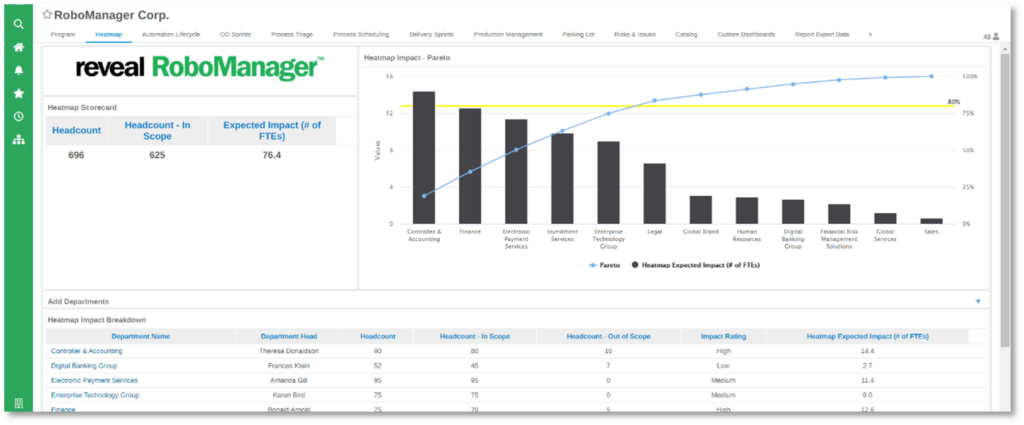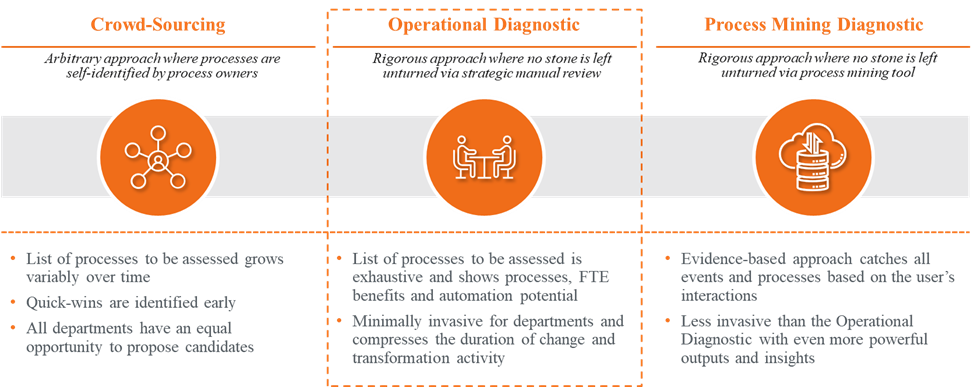
Automation and Change Management: Effective Strategies to Support Buy-in – Part 2
In Part 1 of this blog series (Automation and Change Management: How to Convert at the Goal Line – Reveal Group), we introduced a 5-step approach to change management and discussed how to apply it to launching an automation program and foster buy-in from key stakeholders. In this blog, we will focus on some ancillary topics related to change management:
- The Evolution of Change Management in Your Automation Journey: how the change management mindset should progress after a program has gone live and begins to scale.
- Measuring the Impact of Automation: How to monitor results, tie results back to the business case, and ultimately determine if the automation was successful
- Change Management Scenarios: What are some foreseeable change management scenarios within the various stages of an automation program
The Evolution of Change Management in Your Automation Journey
Change management is crucial in any Robotic Process Automation (RPA) implementation journey. It helps organizations plan, manage, and communicate the changes required to implement RPA solutions effectively. The evolution of change management in RPA implementation should be a continuous process. After the RPA program goes live, developing a proactive mindset toward change management is essential to ensure a successful and smooth scaling process.
Once an RPA program has gone live, the change management mindset should progress from reactive to proactive. Instead of reacting to changes as they arise, the organization should anticipate and plan for potential changes in advance. This proactive approach can involve creating a change management strategy that considers the RPA program’s scalability. The strategy should identify potential risks and challenges that may arise during the scaling process and outline a plan to mitigate these risks. It is also important to ensure that all stakeholders are engaged and aware of the potential changes that may occur. This can involve regular communication and training programs to prepare the workforce for potential changes. Overall, the evolution of change management in RPA implementation is a continuous process that requires a proactive mindset to ensure successful and smooth scaling.
Another important aspect of the evolution of change management in RPA implementation is the need to continuously monitor and evaluate the effectiveness of the change management strategy. As the RPA program scales, the organization should regularly assess the impact of the changes on the business processes, systems, and workforce. This evaluation can help identify areas where the change management strategy may need to be adjusted or improved to ensure that the organization fully realizes the benefits of RPA. Additionally, regular monitoring and evaluation can help identify potential roadblocks to successfully scaling the RPA program, enabling the organization to take proactive measures to address these roadblocks. Organizations can continuously evaluate and adjust the change management strategy to ensure a successful and smooth RPA journey, from implementation to scaling.
Measuring the Impact of Automation
Many times, the success of an automation program hinges on the ability to communicate payback, return on investment, net promoter scores, and program growth to executive leadership. We have a webinar on this very same topic – Past the Pilot: An Expert’s Approach to Scaling your Intelligent Automation Program. Of those four measures, the net promoter score is the most important from a change management perspective.
Folks who have heard about the net promoter score commonly associate it with market research and how customers rate their likelihood of recommending a company, product, or service. In the context of automation, this measures how the main automation stakeholders perceive the quality of the automated processes and interactions and their level of engagement and satisfaction. Most programs should target scores of at least 70%; the higher, the better (particularly in the early days of an automation program).
Sometimes, it is difficult for automation stakeholders to feel that automation is something to recommend. That is why we must not lose sight of the economic metrics like payback and return on investment; these metrics help communicate to executive leadership and stakeholders alike how well the automation is performing. The stakeholders will need to sign off on those values and use them to gut-check how much value they perceive is coming from the automation. Ultimately, knowing that the automation generates a targeted ROI within a reasonable payback period is a key component of being a satisfied customer.
Most automation platforms provide some operational data collection, aggregation, analysis, and KPI reporting. Data is hosted in a dedicated database, is readily accessible, and can be queried using various tools, including third-party applications (e.g., Tableau, MS Power BI, etc.). Further, these platforms provide real-time transparency of process proficiency from the central management tools included in their products.
At Reveal Group, we leverage our in-house tool RoboManager, which has dashboard and data visualizations available out of the box and are configurable on a per-user basis (for a live demonstration, please check out the video embedded here: RoboManager – Reveal Group). Below, we detail the metrics provided in RoboManager used for monitoring results and ensuring positive change management:
Operational KPIs inherent in RoboManager include:
- Reliability: Percentage of time the automated process was run successfully.
- Recovery: Percentage of time failed processes were restarted and then completed successfully.
- Throughput: Number of completed processes (output) per period.
- Utilization: Percentage of time each process completed per, per period.
- Accuracy: Number of errors [per process/function and period].
The KPIs we focus on in our delivery and tie back to the business case are:
- Savings from Automation
- Automations in Production
- Processes Scoped
- Hours Saved per Year
- Additional Revenue
- FTE savings per Year
- Error Count Reduction
- Processing Time Reduction
- Intelligent Document Processing Accuracy
Change Management Scenarios
Below, we describe two scenarios within the realm of change management that require slightly different approaches, given the unique set of challenges that touch on the aforementioned change management considerations and frameworks. We explain how to apply our change management approach and strategies for each scenario to address the organization’s needs.
Scenario 1
Scenario Description: The organization has an automation Center of Excellence and wants increased automation use from end-users within six months.
From a change management lens, it is critical to identify sufficient automation candidates quickly so the program does not stall and the business stakeholders are not interested. To increase the use of automation in an organization within a short time frame, we recommend embarking on discovery initiatives for the first few weeks and then automating processes that have been assessed for high expected benefits and ROI and low to medium complexity. While it may be tempting to crowdsource RPA opportunities across the whole enterprise, we recommend a more systematic approach involving an Enterprise Heat Map followed by an Operational Diagnostic.
We recommend identifying areas across the organization suitable for automation via an Enterprise Heat Map. In an Enterprise Heat Map, we first document all the departments and their corresponding headcounts in the organization. Then, we assign an automation potential rating for each department based on our experience with various departments and industries. From there, we combine the headcount and the rating to get an automation potential value, which then, in turn, is summarized in a heatmap to rapidly identify which departments should be targeted for further automation discussions. The screenshot below illustrates how enterprise heat map results are summarized in RoboManager.

Enterprise Heat Map Output (RoboManager)
It is worth noting that the Enterprise Heat Map connects directly to “Step 1: Prepare stakeholders for change” of the Five-Step Approach to Change Management section in our previous post. Specifically, it allows us to communicate to executive leadership with data-backed recommendations of areas to target for automation, and with their buy-in, further discovery work with department leads and other key business stakeholders can commence. As much as we want to go to the department leads directly, it is critical to get the executive leadership’s blessing first so that everyone knows what’s coming.
Once we have identified a few areas in the organization to focus on via the enterprise heatmap, there are several methods we can consider to build the automation pipeline (depicted in the figure below), and for most organizations, we propose our Operational Diagnostic approach to generate innovative ideas quickly.

Approaches to Building a Plentiful Pipeline
The Operational Diagnostic is a systematic, top-down examination to identify processes within a given department or area that possess the most potential for automation benefit, in which all processes are captured for those selected departments. Once we have a comprehensive list of processes, we will assess benefits, automation potential, and any IA techniques required (e.g., RPA, IDP, ML etc.) for each process.
During the Operational Diagnostic, we will conduct Process Walkthrough sessions to understand processes at a detailed level and produce a high-level estimate of effort to deliver the automation and business value to drive the business case (see figure below for inputs captured for each process). Key process metrics will be uploaded to RoboManager, where potential benefit value, complexity, and estimated delivery timeline will be automatically calculated (this is the step where we capture all of the metrics listed in the ‘Measure the Impact from Automation’ section above).

Process Assessment Framework
After collating and analyzing Discover and Process Walkthrough findings, automation candidates will be prioritized in a Findings Report. The report contains a proposed recommendations roadmap shared with the Department Manager and key Team Leaders. Upon leadership approval, process candidates will be allocated to a Squad for delivery. In our previous post, we begin to set up that plan with the business by referring to “Step 2: Design a realistic implementation plan” of the Five-Step Approach to Change Management section.
Scenario 2
Scenario Description: The organization wants to reskill their staff and employees are concerned about losing their jobs. The client needs all parts and levels of the organization to understand automation’s benefits but is unsure where to start.
One of the first activities we perform when rolling out automation programs with our clients is holding workshops with stakeholders to introduce RPA. This is what we mentioned in “Step 3: Implement the change” where stakeholders need to be educated on how they will work alongside RPA; in a sense, educating stakeholders and listening to their concerns must be constant at every stage of the automation program. We first start by explaining what RPA is and what RPA is not. For example, RPA does not replace anyone; it helps employees work on more cognitive and enriching activities while offloading highly repetitive and tedious tasks. We have seen the most success when they see the digital worker as their fellow teammate, and organizations even celebrate their bots’ birthdate!
When deciding which process opportunities to automate, it is always important to frame the business case in terms of productivity increases and the business’s goals. For example, many of our clients want automation for risk and error reduction. When the business’s goals at all levels are considered, this provides even more buy-in with the automated process.
A common pitfall with automation is that the business does not adopt the automated solution and still performs the process as usual because it is ineffective (e.g., it has high exception rates, must be maintained, and low trust). To ensure automation effectiveness, we strictly follow proven stage gates in a well-defined process development lifecycle (PDLC), closely adhere to prescribed configuration standards and testing methods, and use our best practice object design templates and related QA tools (Reveal RoboSuite).
We also have experience with upskilling employees so that they are aware of automation and can learn how to identify good candidates and perhaps even automate the changes themselves via Citizen Development.
Automation cannot succeed in a vacuum
The best automation can only succeed when organizational stakeholders fully support the program. By adequately preparing, designing, implementing, embedding, and managing the results with full stakeholder involvement, change management for automation can be more effective. For more guidance on change management, contact our experts; we’d love to chat.
